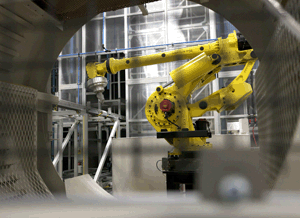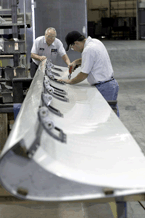Component maintenance, repair and overhaul providers are gearing up for a wave of business, especially from vast narrowbody fleets that have built up over the past decade, by investing in new capabilities and facilities. As aircraft equipment grows in design complexity and expense, its maintenance requires more specialist technical skills, well-furnished workshops and often costly raw material.
These factors make component MRO a high-value field that is less dependent on low labour rates than airframe maintenance. Nevertheless, operators are cost conscious, and equipment is often small enough to be transported long distances to the provider with the best offer.
 |  |
|---|
Chromalloy (left) has opened a foundry for turbine component castings in Tampa and Tulsa-based Nordam offers flight-control repairs |
Tucson, Arizona-based precision component specialist Sargent Aerospace & Defense plans to increase its repair and spare part offerings for mid-generation aircraft - such as the Airbus A320 and A330/A340, and Boeing Next Generation 737 and 777 families - as large numbers of these types are coming out of the manufacturer's warranty period.
Sargent has set up two teams for new product development at its facilities in Miami, Florida and Franklin, Indiana, to concentrate on part restorations under the firm's designated repair representative certificate and replacement parts under its parts manufacturer approval (PMA).
The Dover Corporation subsidiary plans to add 200 repair capabilities a year. On the engine side, the company concentrates on ducting and tubing material as well as quick engine change accessories. While it has been supporting older engine families - such as the General Electric CF6-80 and Pratt & Whitney PW4000 series - new capabilities will span the CFM International CFM56-5B/7B and International Aero Engines V2500 powerplants, says Kevin Connelly, vice-president of aftermarket services.
Fuel valves, hydraulic actuators and high-strength landing gear parts are among the components on Sargent's radar. It also intends to develop fundamentally new capabilities such as composite repair and manufacturing expertise for airframe applications.
To increase its reach, the company is considering whether to add a repair shop to its manufacturing plant in Guaymas, Mexico and open a maintenance facility in Asia.
US engine part repair house, coatings specialist and PMA manufacturer Chromalloy has meanwhile enlarged its footprint in Asia, doubling the capacity of its Thailand repair shop last year. Its largest investments, however, were made at home. The company opened a $30 million foundry for turbine component castings in Tampa, Florida in October and is constructing a $5 million ceramic core production facility on the same site.
Three new PMA high-pressure turbine blades are close to certification, says Peter Howard, vice-president technology and quality assurance. "We see opportunity in the newer, fuel efficient engines," he adds.
Fresh opportunities can be found in old powerplants. Budgetary constraints led the US Air Force to make Chromalloy its PMA pioneer by ordering the world's first non-OEM replacement parts for military engines last year. The company has begun supplying high-pressure turbine blades for F108 engines - the military variant of the CFM56-2B - which power the Boeing KC-135 tanker fleet.
The CFM56 family also remains the focus of Pratt & Whitney's PMA programme. Given the large volume of the latest -5B/7B generations delivered so far or still on order, the peak in overhauls is yet to come. P&W wants to develop more hot-section aerofoils as well as high-value casing. "We see that [CFM56 PMA market] continuing to grow and be a valuable business," says Lynn Gambill, director of global services engineering.
Component repair processes are becoming increasingly complex and costly. In aerofoil replacement repair, for example, original parts are becoming more expensive and elaborate, and there is more scope for more intensive repairs.
Developing repair capabilities for bladed disks - or blisks - is a major objective for General Electric, says Anna Nabb, general manager of engine services component repair. The seamless combination of blades and disks in a single component promises lower weight and greater efficiency in future engines. It also requires sophisticated repairs to avoid premature scrapping if, for example, individual blades have been damaged by foreign object debris.
 |
|---|
© General ElectricGeneral Electric is focused on disk repair |
Novel composite manufacturing and repair processes are equally high on the agenda, as synthetic materials find wider application in new engines: for example, in the shape of three-dimensionally woven composite fan blades in the Leap-X engine. GE is opening a composite manufacturing facility in Alabama and is to increase production elsewhere, says Nabb.
Composite specialist Nordam is also looking to expand its expertise and production base. The Tulsa, Oklahoma-based company wants to develop "deeper, beyond-manual" repair capabilities for damage that would be considered beyond economic repair per manufacturer instructions.
Such techniques have been introduced for nacelle components on CFM56-5B/7B and V2500-A5 engines. With service time increasing, the demand for deep repairs is expected to grow. However, Nordam wants to apply its expertise with autoclave-bonded metal and composite structures to other product areas, too, as airframers step up use of these materials.
GA Telesis - a Fort Lauderdale, Florida-based lessor, parts trader and maintenance provider - pursued local growth when it acquired Ultimate Aircraft Composites in February. While the facility supports a range of components, commercial engine nacelles are the focus. Another aim is to move into the military market.
The company's new commercial component repair capabilities are centred on the 737NG, 777 and A320 families. These areas are hotly contested, with large maintenance companies offering nose-to-tail support, while OEMs try to grow their MRO business and restrict access to engineering data required to develop repairs and increased regulatory oversight of test equipment standards.
Brad Herring, general manager of GA Telesis's south-eastern component repair group, admits that these factors have hindered the company's "ability to economically add some product offerings", but he sees "many other areas of interest without such restrictions".
EXPANDING SABENA
With seemingly little restriction, Belgium's Sabena Technics has expanded the component repair business of its US subsidiary Barfield, a former EADS branch that focused mainly on avionics and test equipment for Airbus aircraft.
Now the company also supports 737NG, Bombardier Dash 8/CRJ and Embraer 170/190 aircraft. Revenue increased from $65 million in 2008 to $80 million last year, says Sabena's chief executive Christophe Bernardini, and $100 million is forecast for 2012.
January brought the signing of a power-by-the-hour component support contract covering 60 Avianca-Taca A320-family aircraft. Barfield is to set up a joint venture repair shop at the airline's MRO facility in Bogotá, Colombia. This will concentrate on third-party customers.
Canadian MRO provider Aveos has opened a component repair shop near its base in Montreal, with operations commencing in January. Thanks to a lean manufacturing-inspired layout, the facility is expected to improve repair efficiency and part turnaround time by 20%, says Gerald Kent, vice-president component solutions. He adds: "We have plenty of upward capacity."
Source: Flight International
















